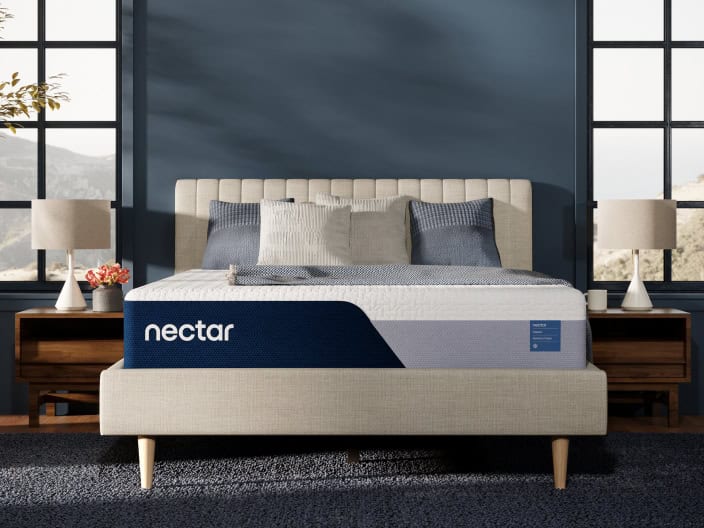Duvet vs Comforter: What’s the Difference?
Share
Fact checked
Reviewed by experts
Updated
December 27, 2022
Quick read
6 mins to read
List of Content
Duvet vs comforter: which is better? Which one to buy? Are you unable to decide whether to buy a duvet or a comforter? Well, buying a bed is always a tough decision. With different types of bedding materials and accessories in different colors and patterns available in the market, you are sure to be confused. Bedspread is not just a bedspread!
Do you want to make the right decision and sleep in comfort? Read this comparison guide to know the similarities and differences between a duvet and a comforter, how to use a duvet, comforter sizes, and duvet sizes, and the pros and cons of each bedding item. This post also covers things to consider before deciding between a duvet or a comforter.
Difference Between a Duvet and a Comforter
A duvet is available in two pieces: an insert that works as a fill and a cover. The duvet insert fits inside a duvet cover. On the contrary, a comforter is a single piece of bedding quilted with a filling and doesn’t need any additional outer layer or a duvet cover. It’s ready to use once you take off the package.
Some people prefer to use a duvet cover on the comforter to prevent stains or damage due to spills. But, it is not necessary to use a comforter as an insert for a duvet cover.
What Is a Duvet?
Originated in Europe, a duvet is a plus quilt stuffed with soft and fluffy inner fibers of geese and ducks that give you enough warmth and comfort during cold winter nights. However, modern manufacturers stuff duvets with synthetic fibers and firmer feathers held in place with stitching. Today duvets are available in a wide range of designs, colors, and materials (silk, cotton, and blends).
What is a Duvet Cover?
A duvet cover is a protective covering that perfectly fits over the duvets. It is a very daunting process to clean a thick, heavy duvet (not all duvets can be machine washed), but not when you slide your duvet inside a duvet cover and close up the ends with a zipper or ties or buttons. Duvet covers are easy to remove and wash whenever they are dirty, damaged, or stained due to spills.
While duvets require professional cleaning or dry cleaning, you can easily wash duvet covers in a conventional household washer. As long as you follow the care instructions, there won’t be any harm to the filler or material.
What is a Coverlet?
Duvets also come with a coverlet that can be used over a thick duvet as a decorative layer to enhance the aesthetic appeal of the bedroom. A coverlet is usually woven or quilted and is not attachable. You can also use a coverlet on the comforter, chairs, and sofas.
How to use a Duvet Cover?
- Remove the packaging and turn the duvet cover inside out.
- Slowly slide the duvet insert inside the cover just like a pillow in a pillowcase.
- Once you create the bundle, invert the cover around the sides of the bundle.
- Then close the duvet cover using a zipper or ties or attached buttons.
- Now unroll the bundle.
Pros and Cons of a Duvet
Duvet pros
- You can clean it easily
- Very easy to make the bed with
- Lightweight fabric
- Fluffier in texture
- Easy to replace the cover and insert, if it gets worn out or stained
- Easily enhances the look of your bedroom
- It’s versatile, easy to change the style
Duvet cons
- Duvet filling can clump up
- Sometimes difficult to assemble
- Prone to bunching inside the cover
- Provides less coverage (overhang) as compared to a comforter
What Is a Comforter?
A comforter is a blanket designed as a single piece without a cover to be used on your bed. It is filled with synthetic fiber materials and stitched in a manner so that the filling is evenly distributed and secured.
A comforter is one final piece, fluffy, thick, and decorative, which enhances the aesthetic touch of your bed. They are available in many different patterns and colors. Comforters come along with bedding sets with sheets, pillowcases, and other coordinating pieces all designed for the same bed size. Under the comforter, you can use a thin blanket or a sheet. Comforters don’t need a duvet cover!
However, the drawback is they are a bit difficult to clean. Some are machine-washable, some require dry cleaning and some are too heavy to squeeze into household washers. The good news is some companies manufacture a top sheet to protect a comforter against spills and stains and ensure sleep hygiene.
Pros and Cons of a Comforter
Comforter pros
- Provides good coverage (overhang) as compared to a duvet
- No need to assemble
- Maintains its shape
- Offers a layered look to the bed
- Filling is built-in and evenly distributed
- Available in matching bed sheets and pillowcases, makes shopping easier
- Ready to use right out of the bag, no covers or outer layers required
Comforter cons
- Not easy to clean as comforters are larger than duvets
- Not warm enough during winters
- They tend to flatten over time
- Less stuffing so less fluffy and thicker than duvets
Duvet Sizes vs Comforter Sizes
- Duvets look more fluffy, but smaller than comforters
- Unlike comforters, duvets fit the exact size of the mattress
- Duvet vs comforter: both are available in different mattress sizes (with variations in dimensions)
Below is the chart for duvet vs comforter sizes:
| Size | Duvet | Comforter |
|---|---|---|
| King/Cal King | 104 inches x 90 inches to 108 inches x 94 inches | 102 inches x 88 inches to 110 inches x 98 inches |
| Queen | 88 inches x 90 inches to 90 inches x 94 inches | 86 inches x 96 inches to 88 inches X 100 inches |
| Full/Double | 80 inches x 89 inches to 90 inches x 94 inches | 81 inches x 86 inches to 84 inches x 88 inches |
| Twin/Twin XL | 64 inches x 89 inches to 70 inches x 88 inches | 66 inches x 86 inches to 68 inches x 88 inches |
| King/Cal King | 104 inches x 90 inches to 108 inches x 94 inches | 102 inches x 88 inches to 110 inches x 98 inches |
Please note:
- The sizes of duvets and comforters for different mattresses given in the above chart may vary by a few inches depending on the manufacturer.
- Carefully consider your mattress size and thickness before buying a duvet or a comforter.
Things to Consider Before Deciding Between a Duvet or a Comforter
Budget
Always fix your budget and that will help you decide between duvet vs comforter! Well, talking about the cost price, both a duvet and a comforter are available at the same price. The prices may vary depending on the type of material used and the brand.
Duvets and comforters filled with synthetic fibers are cheaper when compared to those filled with down feathers. Buying two pieces of a duvet separately along with a duvet cover can add an extra cost. Moreover, matching comforter sets (include pillowcases and sheets) are also easily available and are economical than buying bedding items separately.
Personal Style
If you want to give your bed a minimalistic look, opt for a duvet that often comes in a simple and cleaner design. Plus duvets are fluffier and fit the exact size of the mattress. You may avoid the top sheet and just use a duvet and cover. Whenever you want to transform your bedding, just slide a new cover. That’s quick and inexpensive!
On the contrary, comforters provide good coverage and hang from the sides, giving a layered look to the bed. You can be sure of cohesive design when buying comforters (comforter sets) because they go well with sheets and pillowcases. Unlike duvets, comforters are great for decoration!
Warmth and Loft
Duvet vs Comforter: Comforters have less filling so they are thinner and less warm than duvets. If you are buying a comforter, please remember you’ll need a top sheet, blanket, or quilt for colder nights. On the contrary, duvets are plusher and loftier with excess filling. They are warm enough in winters and you don’t need to use an additional sheet or blanket for warmth.
So, before buying a duvet or comforter, consider where you are going to live and the temperature of the place in winters.
Maintenance
Unlike a comforter, a duvet is easy to clean and make the bed with. Also, it is easy to strip off and wash a duvet cover or an insert, if it gets worn out or stained. Comforter is one single, heavy piece, so you cannot handle it alone. You have to take it to a dry cleaner for proper cleaning.
If you have children or a pet that spoils your bedding too quickly, it is wise to buy a duvet.
Durability
Duvet vs comforter: People believe duvets last longer than comforters! You can easily replace the duvet cover and can change the look of your bed with a new cover whenever you want. This saves an extra cost on the new duvet. On the other hand, comforters being a one piece of bedding, you’ve to buy a new one every time the old one is damaged.
What Should You Choose Between a Duvet and a Comforter?
You should choose a duvet if you need a warmer blanket that looks fluffy, easy to clean or replace, and is versatile.
You should choose a comforter if you’re looking for a ready-to-use cover that can add a decorative look to your bed instantly. People who want something that offers a layered look to the bed and is easy to buy with a matching set often opt for a comforter.
Bottom Line
Duvet vs comforter: which is better? The only similarity between both types of bedding is they work as a thick, fluffy blanket on our bed. Both work as a decorative layer and add the aesthetic touch with or without a cover. There are some minor differences between both items. While duvet is used with a cover or coverlet, a comforter is used as it is. Buyers can easily choose what is best for them considering the budget, personal style, need for warmth, and loft. You are suggested to carefully weigh the pros and cons of a comforter vs duvet before buying one.
For more information on duvet vs comforter, call us today!
FAQs
A duvet cover works as a pillowcase for a pillow. It protects your duvet from stains and spills. It is easy to remove and wash or replace.
The duvet insert goes in a duvet cover. Insert is stuffed with synthetic fibers and firmer feathers held in place with stitching.
A duvet is used as a top cover on a bed to keep the sleeper warm and comfortable.
- Bamboo
- Cotton
- Microfiber
- Down-filled
- Faux suede
- Linen
- Polyester
- Satin
- Silk
- Flannel
- Fleece
- Fur
- Jacquard
This website does not offer medical advice nor professional medical services; rather, it is provided solely for educational, informational, and/or entertainment purposes. Individuals seeking medical advice should consult a licensed physician. The information provided should not be used for diagnosis or treatment of any condition, disease, or injury. When you have a medical condition, you should always talk to licensed doctor or other certified medical professional. You should never delay seeking professional medical advice or treatment based on the contents of this website. Call 911 or immediately go to the nearest emergency room if you think you may have a medical emergency. The contents of this website are provided “as-is”, Sleep Authority and its parent, subsidiaries, affiliates, employees, contributors disclaim any warranty of the information contained herein. Please contact using contact form to report any errors, omissions, misinformation, or abuse.
Sleep Authority is brought to you by Resident, the company that brings you Nectar, DreamCloud, Awara, Wovenly, Bundle, Home Well Designed and Level Sleep.






